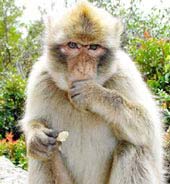Infants and gibbon memorize the same
Infants and gibbons use the same tricks to remember the location of objects, but when children grow up their ways also change. The result may indicate evolution from the distant ancestors' brains to today's humanity.
There are two basic tactics that animals use to memorize objects: through characteristics or locations of objects in space.
 (Photo: treknature) Every animal that scientists test exploits both of these strategies. But if the experiment forces animals to choose one of two ways, some species like chickens and toads prefer to use characteristics-based tactics. Fish or dogs use location-based tactics.
(Photo: treknature) Every animal that scientists test exploits both of these strategies. But if the experiment forces animals to choose one of two ways, some species like chickens and toads prefer to use characteristics-based tactics. Fish or dogs use location-based tactics.
Researcher Daniel Haun at Max Planck Institute for Evolutionary Anthropology in Germany and colleagues investigated the orangutans, bonobos, chimpanzees, gorillas and humans. They want to see if people and their closest relatives use the same strategy to remember things. Any change between species or in a species reveals information about evolution.
At Leipzig Zoo, scientists hide rewards such as grapes, bananas or toys in a wooden niche, bird's nest or stone cavity.
Sometimes the reward is hidden under the same object but the location changes. Then characteristics-based tactics will be suitable to find this object. Other times, rewards are hidden in the same place but under other objects. Location-based tactics will be suitable for search.
When babies are 1 year old, they like tactics based on the location of other primates. This shows that the human brain and gibbons start similarly, at least in remembering things. The most recent common ancestor of humans and other large gibbon from 15 million years ago, shows that this common hobby is part of the brain structure from that time.
However, 3-year-olds like more feature-based tactics. The researchers found that this shift coincided with the time when people began to walk into social life and learn new skills such as language.
In the future, Haun hopes to find out if developed brain regions, like languages, are related to changes in the way people remember things.
MT
- Motherhood between dogs and gibbons
- Discovering the world's smallest gibbon fossils lived 12.5 million years ago
- Discovered rare gibbon species in Indochina
- 5 things you need to know about breastfeeding around the world
- Explore the moon with a gibbon
- Rescue a rare and precious black cheeked gibbon
- Discover the largest Siki gibbon population in Vietnam
- Gibbon is capable of imitating movies
- What people learn while sleeping
- Rare and white cheeked gibbons are released to the forest
- Do you know how many faces each of us can remember?
- Discover a tiny gibbon
 'Fine laughs' - Scary and painful torture in ancient times
'Fine laughs' - Scary and painful torture in ancient times The sequence of numbers 142857 of the Egyptian pyramids is known as the strangest number in the world - Why?
The sequence of numbers 142857 of the Egyptian pyramids is known as the strangest number in the world - Why? History of the iron
History of the iron What is alum?
What is alum?